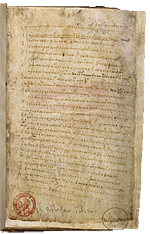Palatine Anthology (Anthologia Palatina)
The Heidelberg Palatine Anthology, Cod. Pal. graec. 23, was most likely created in Constantinople in the 10th century. For the preservation and tradition of Greek literature, this Codex is of as huge importance as the Codex Manesse for medieval German poetry.
The 3,765 epigrams on 614 pages document, through 23,000 verses, over 1600 years of Greek literary history, from its ancient origins in the sixth century BC to the Byzantine 10th century. A considerable number of these poems have only survived within this existing manuscript. The precious parchment Codex is largely based on an older anthology („Blütensammlung“), from the Constantinopolitan court clergyman and scholar Konstantinos Kephalas, which was created in around 900 and which aimed to produce a comprehensive compilation of earlier collections. The thematic diversity of the poetry in the anthology – illness and death, love and eroticism, mythology and Christianity, the working environment of mariners and farmers – neglects to consider hardly any areas of life.
To this day, the medieval history of the Codex remains largely unknown. Like many Greek manuscripts, it most likely came to Italy in the first half of the 15th century. In approximately 1600, the anthology reached Heidelberg and was kept in the famous Bibliotheca Palatina here, from which it received its name, Palatine Anthology (Anthologia Palatina). In 1623, the anthology was brought to the Vatican, alongside the entire Bibliotheca Palatina, where a smaller part of the collection was then separated into a second volume. In 1797, together with 500 other notable Vatican manuscripts, the two sections of the anthology were transported to Paris, on the orders of Napoleon. The first, more extensive volume later returned to Heidelberg in 1816.
(Dr. Veit Probst, Universitätsbibliothek Heidelberg, 10/2012)
Zum digitalen Faksimile:
Anthologia Palatina — Konstantinopel, 2. Hälfte 9. Jh. und 1. Hälfte 10. Jh.
Teil 1 (fol 1-614): Universitätsbibliothek Heidelberg, Cod. Pal. graec. 23
Teil 2 (fol. 615-662): Paris: Bibliothèque nationale de France, Supplément grec 384
Translated by Emily Giles

